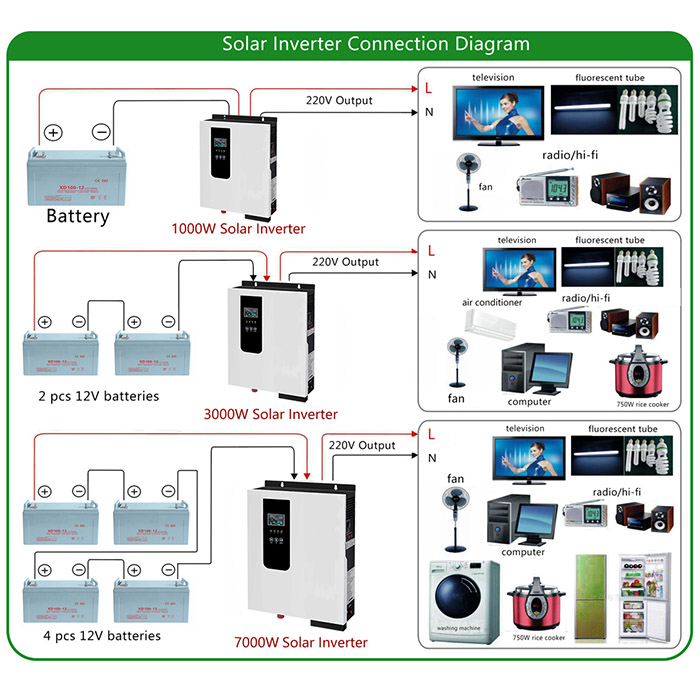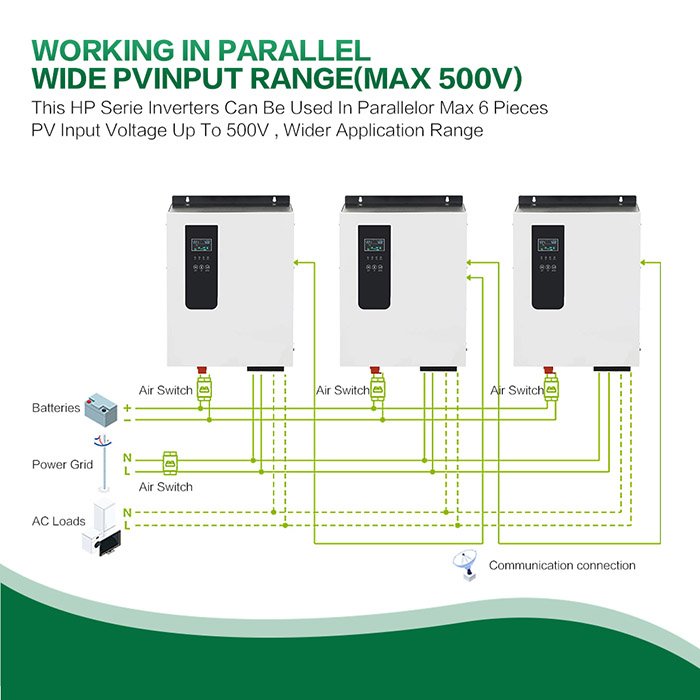What is the trend of PV inverter demand?
 May 23,2022
May 23,2022

 Rekesun
Rekesun
The energy storage photovoltaic inverter integrates the functions of photovoltaic on grid power generation and energy storage power station. It will store electrical energy when the electrical energy is excessive, and invert the stored electrical energy and output it to the grid when the electrical energy is insufficient, which is one of the main development directions in the future.
The photovoltaic inverter is the control center of the photovoltaic power generation system, which can convert the DC generated by the components into alternating current for grid-connected or load use. Photovoltaic inverter is mainly composed of power conversion module, microcomputer control module, EMI module, protection circuit, monitoring module and human-computer interaction module. Its development depends on the development of electronic circuit technology, semiconductor device technology and modern control technology.

(1) Technology Trend 1: Power modularization accelerates series penetration, and new and replacement demands resonate.
Photovoltaic inverters can be divided into centralized, series and micro inverters according to their working principles. Due to the different working principles of various inverters, the application scenarios are also different:
(1) The centralized inverter is mainly suitable for large centralized power stations with uniform illumination. The centralized inverter first aggregates multiple parallel series to the DC input, and after tracking the maximum power peak, it is converted into AC power in a centralized manner. Usually the single machine capacity is above 500kw. Because the centralized inverter system has high integration, high power density and low cost, it is mainly used for large-scale centralized photovoltaic power plants such as large workshops with uniform sunshine and desert power plants.
(2) The series inverter is mainly suitable for scenarios such as small and medium-sized rooftops and small ground power stations. Based on the concept of modularity, the series inverter tracks the maximum power of 1-4 groups of photovoltaic strings individually, and then firstly inverts the DC power generated by them into AC power, and then aggregates and boosts it before connecting to the grid. Therefore, the centralized power supply stage is smaller, but the application scenarios are more abundant. It can be applied to various power stations such as centralized power stations, distributed power stations, and rooftop power stations, and the price is slightly higher than that of centralized power stations.
(3) The micro-inverter is directly connected to the grid, which is mainly suitable for household and small distributed scenarios. The micro-inverter tracks the maximum power peak of each PV module separately, and then merges into the AC grid through the inverter. Compared with the first two inverters, it has the smallest volume and the lowest power, and the general power is below 1kw. It is mainly suitable for distributed household and small distributed industrial and commercial rooftop power stations, but it is expensive and difficult to maintain once it fails.
Benefiting from the increase in the proportion of distributed generation and the accelerated popularization of large-scale power stations, the market share of series inverters has gradually increased. According to GTM statistics, the global market share of series inverters in 2019 was 52%, an increase of 11 PCTs from 2015. According to CPIA statistics, the domestic market share of series inverters in 2020 is 67%, an increase of 34.5 percentage points over 2016. The specific reasons are as follows:
(1) Distributed photovoltaic power generation is the preferred cascade scheme, and the increase in the proportion directly leads to an increase in the share of the cascade:
The centralized photovoltaic power station has large investment, long construction period and large area, and is mainly built on the ground with uniform illumination. Concentrated photovoltaic power plants can make full use of abundant and stable solar energy resources. By building large-scale photovoltaic power stations and connecting to high-voltage transmission systems for long-distance recombination, the generated energy can be directly transmitted to the grid. The grid purchases all electricity at the benchmark price of photovoltaic power generation and agrees to distribute power to users.
Distributed photovoltaic power plants have low investment threshold, fast construction speed, small footprint and flexible installation, which are the main directions of photovoltaic development in the future. Distributed generation refers to the power supply system located near the user's location. In addition to the user's own use and nearby utilization, the generated electricity can also transmit excess electricity to the local distribution network. Solar energy resources have the characteristics of dispersion and low energy density, and have the natural advantages of distributed power generation. Due to the low threshold for centralized investment, the willingness of high electricity price users such as parks, large industries, industry and commerce to use distributed generation has been continuously strengthened, and direct connection has promoted the gradual increase of the market share of series inverters.

(2) The advantages of MPPT enabling and easy maintenance of series inverters are obvious. The price difference between single-unit power and centralized power gradually narrows with the amplification of single-unit power, which accelerates the penetration of the large-scale power station market:
The series inverter has the advantages of high power generation, high reliability, high safety, and easy installation and maintenance. When a component is shaded by shadows or fails, due to its multi-channel MPPT, it will only affect the power generation of a few series, which can minimize damage, reduce array mismatch loss, and improve efficiency, and is gradually applied in the large-scale power station market.
Previously, the main reason why series inverters failed to replace centralized inverters on a large scale was high cost, and the maximum power of a single unit was also limited by power devices and circuit layout. However, thanks to the iterative upgrade of upstream IGBT, MOSFET and other core devices, the continuous development of superimposed power module technology, the continuous improvement of the power density of a single series inverter, the rapid decline in price, and the outstanding cost performance. More and more large-scale power plants choose series inverter solutions. According to PV-tech statistics, among the centralized procurement projects announced by domestic central enterprises in 2020, the bidding ratio of series inverters hit a new high, accounting for 74%.
The demand for "plus + exchange" has accelerated the outbreak of the photovoltaic inverter market. Different from the 25-30-year service life of photovoltaic modules, the service life of electronic components such as IGBTs used in photovoltaic inverters is generally 10-15 years, so the inverter needs to be replaced at least once during the operating cycle of photovoltaic power plants. In 2010, the newly installed photovoltaic capacity in the world has reached 17.5GW. As more photovoltaic power plants enter the period of technical renovation of the stock, the demand for replacement will continue to increase.
(2) Optimization space 1: The localization of the industrial chain is upgraded and iteratively superimposed, and the localization is accelerated to go overseas.
The rigid cost of photovoltaic raw materials is a key point to reduce costs. The cost of photovoltaic raw materials accounts for more than 80%, mainly including electronic components, mechanical parts and auxiliary materials. Product pricing is mainly based on cost plus, brand positioning and comprehensive judgment on local market competition.
(1) The localization of the industrial chain promotes the reduction of procurement costs: The domestic manufacturing industry has developed rapidly, most of the raw materials have been localized, and the general materials market is fully competitive, and the purchase price has dropped year by year. However, due to the high technical threshold, integrated circuits and semiconductor devices are still provided by overseas manufacturers, and it is expected to further reduce procurement costs after localization.
(2) The upgrade of electronic and circuit technology helps to reduce costs and increase efficiency: in photovoltaic power generation applications, the cost of traditional inverters based on silicon-based devices accounts for about 10% of the system, but it is one of the main sources of system energy loss. one. The conversion efficiency of photovoltaic inverters using SiC MOSFET power modules can be increased from 96% to more than 99%, the energy loss can be reduced by more than 50%, and the cycle life of the equipment can be increased by 50 times, thereby reducing the system volume, improving power density, and extending the device. service life.
For example, the market penetration rate in the United States and Japan still has potential for improvement, and the domestic inverter has a significant cost advantage, thus accelerating the overseas market and optimizing the shipping structure. Overseas markets have relatively high requirements for product performance and after-sales, and the competition atmosphere is relaxed. PV power station inverters in the United States and Japan are still mainly provided by local brands; for example, two manufacturers, SolarEdge and Enphase, occupy more than 80% of residential inverters in the United States by virtue of technical and patent barriers; Japan has high barriers to entry and reverse Inverter manufacturers are mainly local companies such as TMEIC, Moron and Panasonic.
Due to the weak price sensitivity of overseas end customers, the cost advantage of domestic inverters is obvious, and the product performance is not inferior to that of imports. The price and gross profit margin of products exported overseas are significantly higher than those in China. Domestic inverter companies are accelerating the development of overseas markets, continuously establishing overseas channels, and expanding brand influence. The market share of Chinese inverter manufacturers among the top 10 manufacturers by shipments has grown rapidly from 13% in 2012 to 54% in 2020.
In 2025, the output value of photovoltaic inverters will more than double, and the overseas market space will be broader. According to estimates, the global output value of photovoltaic inverters will reach 88.9 billion yuan in 2025, and the CAGR from 2020 to 2025 will be 18%, of which the overseas market will exceed 70 billion yuan.
(3) Technology trend 2: energy storage is ready to go to the emerging market of tens of billions of inverters.
Inverters can be divided into photovoltaic on grid inverters and photovoltaic energy storage inverters according to whether they have energy storage. Traditional grid-connected photovoltaic inverters can only convert from DC to AC in one direction, and only generate electricity during the day, so the power generated will be affected by the weather, resulting in unpredictability, etc. The energy storage inverter integrates the functions of grid-connected photovoltaic power generation and energy storage power station. It stores electric energy when there is excess electric energy, inverts the stored electric energy when the electric energy is insufficient, and outputs the stored electric energy to the power grid, balancing the day and night and different seasons. The difference in electricity consumption plays the role of shaving peaks and filling valleys.
The integration of light and storage is an inevitable trend, and policies first promote the allocation and storage of new energy. In theory, in the case of complete photovoltaic power supply, it is necessary to configure 1: 3 to 1: 5 energy storage to achieve uninterrupted power supply. Optical storage integration is expected to become the clean energy solution in the future. In the short term, the demand for energy storage installations is mainly driven by policies and is affected by consumption space and power fluctuations. Governments around the world have accelerated the introduction of a series of relevant policies to encourage the energy storage market, and some provinces and cities in my country have even mandated the allocation of new energy.
Cost exploration improves the economy of energy storage, and the parity of solar energy storage stimulates the explosion of demand. In the long run, considering the fluctuation characteristics of photovoltaic and other new energy power generation and the cost of peak and frequency regulation, the allocation and storage of new energy is an inevitable choice, and the demand will be driven by internal economy rather than policy. As the interface between the smart grid and the energy storage device, the energy storage converter (PCS) is mainly used to control the charging and discharging process of the battery in the energy storage system, and is responsible for the bidirectional conversion between AC and DC. Currently, PCS accounts for about 15.5% of the cost of energy storage systems and nearly 60% of the cost of batteries. With the further exploration of the two costs, the demand after light storage parity will be driven by the policy to the internal economy. Energy storage inverters and grid-tied inverters have the same technology. Although the protection circuit and snubber circuit are different, the hardware platform and topology are similar, so the cost reduction path is basically the same as that of the photovoltaic inverter.
Output value of energy storage inverters: The increasingly diversified business models of energy storage have spawned an emerging market of tens of billions of energy storage inverters. In grid-connected applications, energy storage systems can be divided into power generation side energy storage, distribution side energy storage and power consumption side energy storage according to the different links of power generation, transmission, distribution and use.
The energy storage on the power generation side mainly solves the fluctuation and consumption of renewable energy grid-connected power generation, and the energy storage on the distribution side mainly realizes peak regulation and frequency regulation. The application of energy storage system on the power generation side and the power distribution side usually has the characteristics of large capacity, large area and high investment cost. It is mainly used in large-scale centralized ground power stations, power grid substations and other fields. The power side can be divided into household and industrial and commercial photovoltaic energy storage, which is mainly used to increase the income of power generation and reduce the cost of electricity consumption.
According to the penetration rate of energy storage in the proportion of various energy installations, it is estimated that the installed energy storage demand will exceed 140GW in 2025, and the output value of energy storage inverters will exceed 68 billion yuan, thus making the output value of the entire inverter industry exceed 150 billion yuan.



 Home
Home How to configure and select a PV inverter?
How to configure and select a PV inverter? 







 syplighting.en.alibaba.com
syplighting.en.alibaba.com



